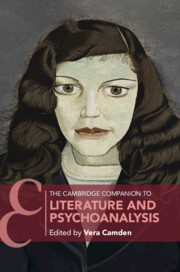Book contents
- The Cambridge Companion to Literature and Psychoanalysis
- The Cambridge Companion to Literature and Psychoanalysis
- Copyright page
- Contents
- Figures
- Abbreviations
- Contributors
- Acknowledgments
- Chronology
- Introduction Reading to Recover
- Part I In History
- Part II In Society
- Part III In Sight
- 10 Frames of Mind
- 11 Psychoanalysis and Children’s Literature
- 12 Reflections on Psychoanalysis and Class
- Part IV In Theory
- Further Reading
- Index
10 - Frames of Mind
Comics and Psychoanalysis in the Visual Field
from Part III - In Sight
Published online by Cambridge University Press: 16 December 2021
- The Cambridge Companion to Literature and Psychoanalysis
- The Cambridge Companion to Literature and Psychoanalysis
- Copyright page
- Contents
- Figures
- Abbreviations
- Contributors
- Acknowledgments
- Chronology
- Introduction Reading to Recover
- Part I In History
- Part II In Society
- Part III In Sight
- 10 Frames of Mind
- 11 Psychoanalysis and Children’s Literature
- 12 Reflections on Psychoanalysis and Class
- Part IV In Theory
- Further Reading
- Index
Summary
This chapter considers psychoanalysis and the visual form of comics, a necessary turn for psychoanalysis as articulated by psychoanalyst Didier Anzieu. Comics and graphic narratives today are more popular than ever and are used to tell stories once considered unpresentable in other media forms. These stories of traumatic experience and historical and political traumas that cannot be put into verbal language have been captured in comics form throughout the twentieth-century as in Art Spiegelman’s Maus or Marjane Satrapi’s Persepolis. As a form used to tell stories of lived experience for so many, comics is ideally suited to the application of literary study through psychoanalysis. The chapter will explore the vexed history, once again, of a psychoanalytic establishment that once endorsed the banning of comics, to the great detriment of the medium, its emerging genres, and the lives and careers of its creators. Now in our own day this form which was so denigrated is gracing the covers of elite journals and has become the central medium of recent autobiographical comics and narratives that take up the subjects of mental health and trauma. This chapter will describe how the turn to visual media as a force for capturing and reconfiguring contemporary culture may be understood from a psychoanalytic perspective.
- Type
- Chapter
- Information
- The Cambridge Companion to Literature and Psychoanalysis , pp. 189 - 205Publisher: Cambridge University PressPrint publication year: 2021

